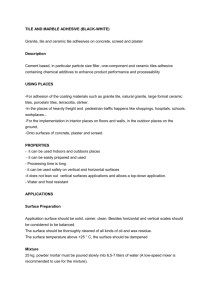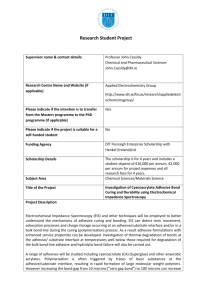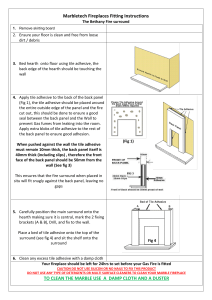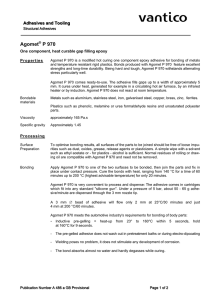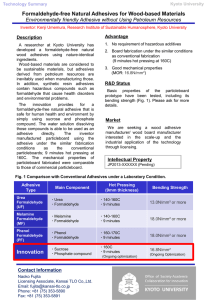Fixing Tiles (Word Document)
advertisement
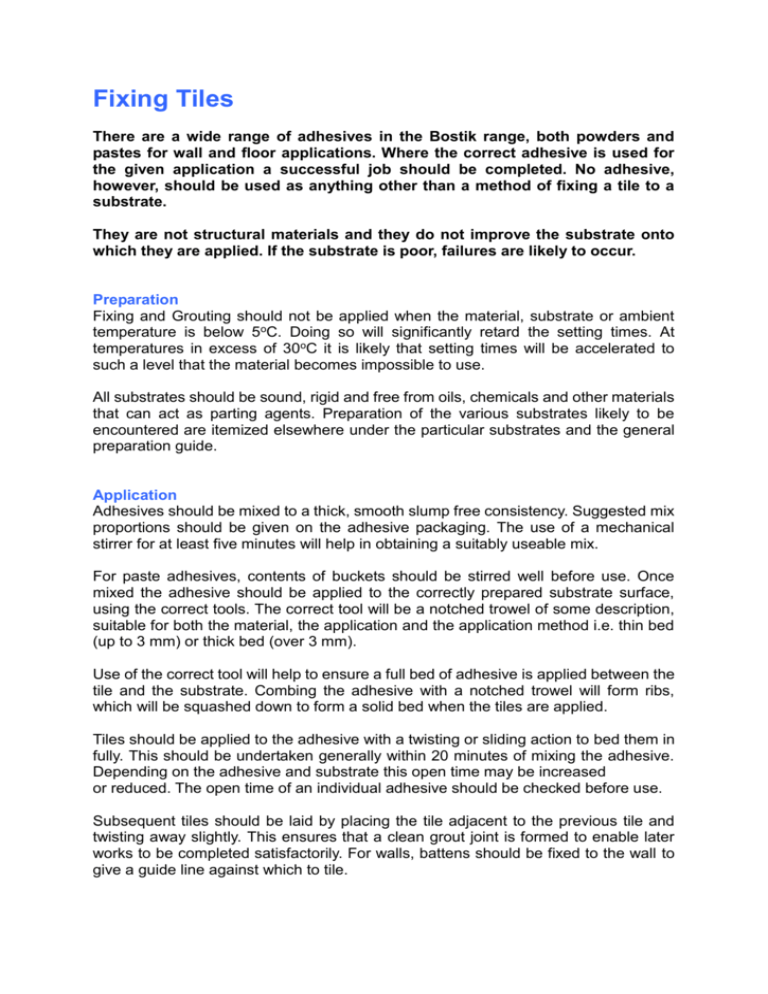
Fixing Tiles There are a wide range of adhesives in the Bostik range, both powders and pastes for wall and floor applications. Where the correct adhesive is used for the given application a successful job should be completed. No adhesive, however, should be used as anything other than a method of fixing a tile to a substrate. They are not structural materials and they do not improve the substrate onto which they are applied. If the substrate is poor, failures are likely to occur. Preparation Fixing and Grouting should not be applied when the material, substrate or ambient temperature is below 5oC. Doing so will significantly retard the setting times. At temperatures in excess of 30oC it is likely that setting times will be accelerated to such a level that the material becomes impossible to use. All substrates should be sound, rigid and free from oils, chemicals and other materials that can act as parting agents. Preparation of the various substrates likely to be encountered are itemized elsewhere under the particular substrates and the general preparation guide. Application Adhesives should be mixed to a thick, smooth slump free consistency. Suggested mix proportions should be given on the adhesive packaging. The use of a mechanical stirrer for at least five minutes will help in obtaining a suitably useable mix. For paste adhesives, contents of buckets should be stirred well before use. Once mixed the adhesive should be applied to the correctly prepared substrate surface, using the correct tools. The correct tool will be a notched trowel of some description, suitable for both the material, the application and the application method i.e. thin bed (up to 3 mm) or thick bed (over 3 mm). Use of the correct tool will help to ensure a full bed of adhesive is applied between the tile and the substrate. Combing the adhesive with a notched trowel will form ribs, which will be squashed down to form a solid bed when the tiles are applied. Tiles should be applied to the adhesive with a twisting or sliding action to bed them in fully. This should be undertaken generally within 20 minutes of mixing the adhesive. Depending on the adhesive and substrate this open time may be increased or reduced. The open time of an individual adhesive should be checked before use. Subsequent tiles should be laid by placing the tile adjacent to the previous tile and twisting away slightly. This ensures that a clean grout joint is formed to enable later works to be completed satisfactorily. For walls, battens should be fixed to the wall to give a guide line against which to tile. It is good practice to remove a tile occasionally as fixing proceeds to check that adequate contact and wetting is being maintained with the adhesive. Thin bed solid bed for floors For thin bed method of application the adhesive should be applied to the substrate using the flat edged side of the trowel. A thin coat at a uniform thickness of about 3mm is spread then ribbed using the notched side. The tiles should then be pressed in to the ribbed adhesive, with a slight twisting action within the open time of the adhesive. In situations where the installation is subjected to frequent or occasional wetting, and areas of high humidity the adhesive should be applied as a solid bed by spreading the adhesive in a thin layer, or alternatively, as a ribbed bed, but to ensure solid bedding a thin coating may be buttered over the backs of the tiles before fixing. Thick bed solid bed for floors For thick areas or with uneven thickness of tiles such as slates, consideration should be given to the use of a pourable thick bed adhesive where the adhesive can be laid in a single application up to a thickness of 25mm. This will help in giving full coverage in awkward positions or with uneven tiles. For thick bed application in the case of surfaces that are not sufficiently true or flat to permit thin bed fixing traditional floor adhesives may be applied as a floated 3-6mm thickness not exceeding 12mm. Before the adhesive is set, spare material should be removed from the surface of the tile and the grout joints. A grout joint half filled with adhesive will generally appear as a different colour to one which is correctly filled with grout. For information on grouting see the relevant section. If marble, mosaics, light coloured natural stone or thin tiles are used consideration should be given to the colour of the adhesive. A grey adhesive might result in such tiles looking dull once the materials have set.

